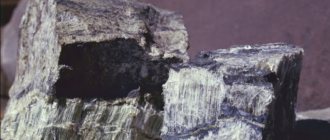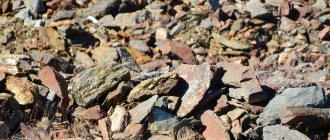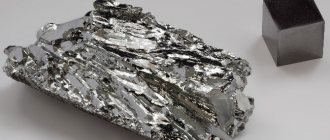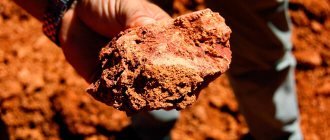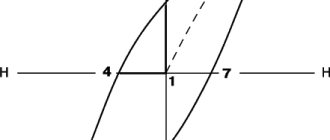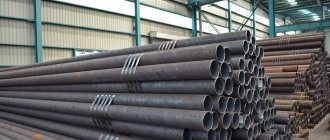Molybdenum is a shiny light gray metal. The history of its discovery, production in the form of a metal and purification from impurities is associated with three famous Swedish chemists: K. Scheele, P. Gjelm, J. Berzelius.
- Flotation
- Alloy steels
Physical properties of the mineral:
- Density – 10.2 gm/cm3 at a temperature of +200C.
- Melting point =» 26200C, which determines its refractoriness.
- Boiling point =» 46390C.
- The structure of the metal is presented in the form of a cubic body-centered lattice.
- Extremely low coefficient of thermal expansion.
- When heated, it lends itself well to mechanical processing.
- Has a high degree of electrical conductivity.
Chemical properties:
- The element is quite stable. Only at a temperature of 4000C does it begin to actively interact with oxygen, forming oxides, and at a temperature of +6000C, trioxides.
- Reacts with halogens.
- Forms unstable blues under the influence of reducing agents such as aluminum, sulfur dioxide, zinc dust.
Methods for extracting molybdenum ores
Within the earth's crust, molybdenum is distributed fairly evenly, although the content of the metal in the depths does not exceed several ten-thousandths of a percent. This chemical element is not found in its pure form, therefore, of the 20 molybdenum minerals known to science, the following have important practical significance:
- Molybdenite, containing up to 60% of the desired substance.
- Molybdoscheelite (zeirigite) – up to 24%.
- Uranium molybdates from molybdenum-uranium deposits.
- To a lesser extent - wulfenite, powellite and ferrimolybdite.
The ores themselves containing molybdenum are divided according to their composition:
- for molybdenum
- copper-molybdenum
- and tungsten-molybdenum.
The method of their extraction is determined mainly by the depth of the mineral massif.
In the mines
When the ore body is located at a depth of more than 500 meters, it is necessary to resort to a closed mining method. Why are shafts constructed and horizontal or inclined passages made in the ground? The method is quite expensive, as it requires a significant amount of work and the involvement of high-tech installations, and in addition, it is unsafe, but at the same time, by modern standards, it is high-tech and makes it possible to extract deposits from the bowels of the earth.
In the quarries
This is where open-pit mining is carried out. Sometimes, in case of surface occurrence, ore is taken directly from the location. If the ore body is covered with upper layers of soil, stripping operations are carried out, accompanied by drilling, explosions and removal of soil into dumps, from where it is returned to its place upon completion of the work.
A quarry is a stepped structure on the side of a mountain or in a pit. It is from these terrace steps that the minerals are collected for further shipment to processing plants.
Molybdenum deposits and ores
Molybdenum deposits can be divided into the following genetic groups and pharmaceutical groups.
A group of endogenous deposits with formations: quartz-molybdenite; molybdenite-scheelite in skarns; quartz-wolframite-molybdenite-greisen; quartz-molybdenite-sericite; quartz-molybdenite-chalcopyrite-sericite; copper pyrite and lead-zinc with molybdenite; uraninite-molybdenite.
A group of exogenous deposits with -formations: wulfenite - in the oxidation zone of lead deposits; carbonaceous and carbonaceous-siliceous, often together with uranium, vanadium and rare elements.
Only endogenous molybdenum deposits are of industrial importance; exogenous deposits, although known in various countries and producing significant concentrations of complex ores, have not yet been developed due to the low molybdenum content. The exception is small deposits of wulfenite.
Quartz-molybdenite formation
It is represented by thin quartz, less often quartz-feldspathic veins interspersed with large flakes of molybdenite. Molybdenite is scattered among coarse-grained vein quartz or confined to vein selvages, where it forms almost continuous rims. The main distinguishing feature of deposits of this formation is a very weak vein alteration of the host rocks and usually large dissemination of molybdenite.
Molybdenite-scheelite formation
in skarns it is typical mainly of tungsten. Molybdenum is of commercial importance only in a few skarn deposits.
Quartz-wolframite-greisen formation
with molybdenite is typical mainly for industrial tungsten deposits. Molybdenite is a minor mineral. Sometimes vertical zoning appears in deposits of this formation (stockwork type). Wolframite mineralization is located in the upper parts of the deposit, and molybdenite mineralization is located in deeper horizons. In addition to wolframite, cassiterite and bismuth minerals are of industrial importance in the ores of deposits of this formation.
Quartz-molybdenite-sericite formation
is most important. Its distinctive features are: intense near-vein alteration of the host rocks, expressed in sericitization, silicification and, to a lesser extent, pyritization and fluoritization; banded or sometimes brecciated composition of the vein mass, when coarse-grained quartz with large molybdenite flakes of the first generation is intersected by fine-grained quartz with microflake molybdenite; the predominance of fine-flaked molybdenite, which represents the main value of the ore. Deposits of this formation are of two types: vein and stockwork.
In the quartz-molybdenite-chalcopyrite-sericite formation
There are successive transitions from molybdenite deposits through copper-molybdenum deposits to copper deposits with a small admixture of molybdenum. These are usually deposits of veinlet-disseminated ores of the stockwork type. The near-vein changes here are expressed, as in the deposits of the previous formation, in sericitization, more intense silicification, pyritization and, less commonly, fluoritization. Chloritization and coalinization of the host rocks are also observed.
Copper pyrite and lead-zinc formations
with molybdenite are not typical for industrial deposits. The low content of molybdenum, as well as the difficulty of isolating it from polymetallic ores, reduce the industrial significance of such deposits.
Deposits of uraninite-molybdenite formation
, as a source of molybdenum, are of little practical importance. Along with molybdenite, uranium-molybdenum minerals are also found in them.
Wulfenite formation
represented by dissemination of wulfenite in the oxidation zone of lead deposits.
Coal and carbonaceous-siliceous formations
, as a source of molybdenum, are currently not of industrial importance due to the low molybdenum content and the difficulty of obtaining molybdenum concentrates from such ores. In these ores, molybdenite usually does not form independent minerals, but is sorbed in carbonaceous and less often in clayey matter.
Of the above ore formations that form molybdenum deposits, only quartz-molybdenite-sericite, quartz-molybdenite-chalcopyrite-sericite and molybdenite-scheelite skarn are of industrial importance. All the rest in total provide no more than 2-3% of world molybdenum production (mainly quartz-wolframite and quartz-molybdenite formations).
Molybdenum deposits of industrial importance are divided into the following industrial types (by shape and size) and groups (by material composition).
1. Molybdenum vein deposits
practically contain only molybdenum and are usually represented by parallel quartz-molybdenite veins 0.3-0.5 m thick, rarely 1.2 m; their extent varies from several tens to several hundred meters. Industrial mineralization extends to a depth of 300-400 m, although in some deposits it is much less.
In monometallic vein deposits, the ores are usually richer compared to the ores of other types of deposits. However, due to the insignificant thickness of the veins during development, the vein mass is greatly diluted and the molybdenum content in the ore entering the processing plant is significantly reduced.
2. Tungsten vein deposits
often contain molybdenum, but usually in very small quantities. The industrial significance of these deposits is determined mainly by the value of tungsten.
3. Stockwork molybdenum deposits
dominate proven reserves and play an increasingly important role in global molybdenum production. The molybdenum content in stockwork deposits is significantly lower than in vein deposits, but their reserves are greater.
Enterprises exploiting stockwork deposits can operate profitably only on a very large scale of production. The largest deposits in terms of reserves provide daily production of up to 30 thousand tons (for example, the Climax mine in Colorado, USA) and even up to 90 thousand g of ore (Bingham mine in Utah, USA).
4. Skarn ore deposits
the shape and size of ore bodies can approach either large stockwork deposits or small and medium-sized vein-type deposits. However, in terms of the material composition of the ores, they are very different from vein and stockwork deposits and therefore are distinguished as a separate type.
In the USA, the main molybdenum and copper-molybdenum deposits are located in the southwestern states: Colorado, Utah, Arizona and New Mexico. This world's largest molybdenum and copper-molybdenum province is confined to the area of young Alpine folding. The largest molybdenum deposit, Climax, is located within the Rocky Mountains (Colorado), and the Questa deposit is located south of it in New Mexico. In the northwest, south of the Great Salt Lake, is the large Bingham (Utah) copper-molybdenum deposit, as well as Tintic and Gold Hill. The third extensive area covers the southern parts of the states of Arizona and New Mexico and the northern part of Mexico with large copper-molybdenum deposits (Miami, Bisbee, Cananea, etc.).
The Questa deposit is one of the richest vein deposits of the quartz-molybdenum-sericite formation. Quartz-molybdenite veins with a thickness of 0.1-0.2 Mt, rarely up to 1-2 m, occur within the ore zone, traced along a strike of 700 m with a width of 100 m.
In terms of reserves and their role in molybdenum production, US copper-molybdenum deposits are in second place after Climax. They are located in Utah, Arizona, Nevada and New Mexico. These deposits are typical representatives of the molybdenite-chalcopyrite ore formation.
Mexico's copper-molybdenum deposits are located in the north of the country in the same ore province as the US copper-molybdenum deposits. The most interesting of them is the Cananea deposit in the state of Sonora.
In Chile, within the alpine fold of the Pacific Rim, three large copper deposits containing Chuquicamata molybdenite are known. Braden, Potrerillos. In terms of reserves and production of molybdenum, the copper-molybdenum deposits of Chile are in second place after the molybdenum and copper-molybdenum deposits of the United States. In Canada, most molybdenum deposits are represented by small skarn-type ore bodies and pegmatites.
Molybdenum mining in Canada is based mainly on Canada's largest molybdenum deposit, La Corpe. This deposit is located in Quebec and consists of a series of quartz veins in granite near its contact with biotite shales. Ore bodies are traced along the strike for 300 m. The average molybdenum content is 0.24% with associated bismuth content.
Australia's molybdenum deposits were the pioneers of the world's molybdenum mining industry, during the period 1900–1910. The amount of molybdenum mined amounted to 60% of world production. From 1950 to 1955 Australia produces only 0.3% of the total world molybdenum production in capitalist countries. The bulk of Australia's molybdenum deposits are located on the east coast of the mainland within New South Wales and Queensland. Ore reserves in individual deposits and total reserves in Australia's numerous deposits are small.
In Norway, the most significant molybdenum deposits are located in the southern part of the peninsula. Among them, the Knaben deposit is the largest. The main ore body is represented by a branching vein in a mineralized zone in granite. The total thickness of the ore zone is determined to be 9 m with an average molybdenum content of 0.2-0.3%. The Quina deposit is located 1.5 km from Kiabena and is represented by a gently dipping quartz vein in granite in contact with brecciated quartz-pegmatoid rock. The average molybdenum content in the ore mass is 0.15-0.20%. In the Knaben area, as well as in the Moi area, located 50 km southwest of Knaben, and in the Telemarken area, there are several other similar but smaller molybdenum deposits.
Molybdenum production processes
Flotation
Flotation (in fact, the floating of particles pre-treated with oils and air on the surface of a liquid) is the main method of enriching molybdenum ores.
Molybdenite is the main mineral for the production of molybdenum, because it provides 99% of the industry's needs for this metal and is well subject to flotation. The fact is that in the process of grinding molybdenite, surfaces with strong hydrophobic (not wetted by water) properties are revealed.
Using pine oil for foaming, and oils of heavy petroleum fractions as collectors, they achieve 90% of the concentrate. The process occurs in stages:
- At the beginning, sulfides are floated.
- Then - molybdenite with suppression of iron and copper sulfides under the influence of sodium compounds in an alkaline environment.
Repeated repetitions make it possible to achieve a high level of molybdenum concentration.
Burning
The basis for the production of molybdenum trioxide, used for alloying steels, smelting ferromolybdenum, obtaining molybdenum salts of high purity, and being the raw material on the way: trioxide or anhydride - powder - compact malleable metal, is the process of oxidative roasting.
The concentrators are loaded into an oven and heated at a temperature of 600-6500C, while avoiding overheating and melting. The result of the process is useful molybdates, as well as oxides and sulfates of foreign impurities. For firing, multi-hearth furnaces with stirring, muffle furnaces, chamber furnaces with manual cinder raking, rotating tubular units or fluidized bed furnaces are used.
Pressure treatment
The resulting molybdenum ingots undergo hot pressure treatment in order to produce the required shapes. To do this, in order to change the internal structure of the casting, it is recommended to first subject it to pressing. There are many promising developments in this direction. In particular, one of them involves air blowing and sound exposure with frequencies of 140-160 dB for 10-20 minutes. This significantly reduces the machining process and provides the required level of mechanical performance.
Molybdenum ores, minerals and concentrates
The molybdenum content in the earth's crust is 3 ∙ 10-4%. Known molybdenum minerals: molybdenite MoS2, powellite CaMoO4, wulfenite PbMoO4, molybdite (ferromolybdite) Fe2(MoO4)3 ∙ nH2O(n = 7-8), molybdescheelite Ca(W, Mo)O4, lindgrenite Cu3(MoO4)2(OH) 2, kechlinite Bi2(MoO4)O2, uranolybdate UO2 UO3 2MoO3, ilsemannite Mo3SO3 nH2O. The first four minerals are of industrial importance. MoS2 is the most common of these, and is the main molybdenum-containing mineral in concentrates used to produce molybdenum alloys. Molybdenite MoS2 occurs in quartz veins, often together with scheelite (CaWO4), wolframite (Fe, Mn)O4, cassiterite SnO2, chalcopyrite CuFeS2 and other minerals, for example, arsenic and bismuth. Ores are divided into simple quartz-molybdenite, copper-molybdenite and molybdenum-tungsten. Simple quartz-molybdenite ores contain from a few tenths to 1% Mo. The content of other sulfides, except MoS2, is insignificant. Copper-molybdenum ores are associated with secondary quartzites. The concentration of molybdenum in these ores is several hundredths and sometimes thousandths of a percent [13]. Such ores include ores from large copper deposits, such as Kounradskoye and Boshchekulskoye (Kazakhstan), Almalykskoye (Uzbekistan) and Karzharakhskoye (Transcaucasia), which are an important source for the production of molybdenum concentrates. Copper-molybdenum ores contain ~0.7% Cu and 0.01% Mo. Using multi-stage enrichment technology, at the first stage a collective concentrate containing 25-30% Cu and 0.3-0.5% Mo is isolated, and copper (14% Cu, 23% SiO2, 20% Fe) and molybdenum concentrates are obtained from it. An important source of copper and molybdenum is the copper-molybdenum ore of the Erdenet deposit (MPR), where a mine was built with funds from the countries of the former CMEA.
Skarn (polycrystalline, formed as a result of the replacement of some minerals by others) molybdenum-tungsten ores contain molybdenite together with scheelite (CaSO4), pyrite (FeS2) and chalcopyrite, the content of which is usually insignificant. This type of ore includes the ores of the Tyrn-Auz molybdenum deposit - tungsten ores in the North Caucasus. Molybdenum ores are enriched mainly by flotation. Molybdenite has good wettability with hydrocarbons, and therefore effective collectors during molybdenum flotation are usually kerosene, transformer, spindle and other neutral oils. Thus, when enriching the molybdenum-tungsten ores of the Tyrna-Auz deposit, molybdenite is initially isolated by flotation. A certain part of powellite (CaMoO4) is isomorphically associated with scheelite (CaO4), and molybdenum concentrates contain some tungsten [14].
For the production of ferromolybdenum and alloys, molybdenum concentrates are used, in which molybdenum is bound into molybdenite MoS2 (Table 1.1) and which are pre-oxidatively roasted to remove sulfur.
Table 1.1 - Chemical composition of molybdenum concentrates according to GOST 212 - 76,%
| Brand | Mo, % (not less) | SiO2 | As | Sn | P | Cu | Na2O | WO3 | Sb |
| KMG - In KMG - 1 KMF - 2 KMF - 0 KMF - 1 KMF - 2 KMF - 3 KMF - 4 | 58,0 56,0 54,0 52,0 51,0 48,0 47,0 45,0 | 0,3 0,4 0,7 4,0 5,0 7,0 9,0 12,0 | 0,04 0,04 0,07 0,03 0,04 0,06 0,07 0,07 | 0,01 0,01 0,01 0,02 0,03 0,05 0,07 0,07 | 0,01 0,01 0,02 0,02 0,03 0,04 0,05 0,05 | 0,01 0,01 0,02 0,4 0,4 0,8 1,5 2,5 | 0,8 0,8 1,0 — — — — — | 2,0 4,5 5,0 — — — — — | 0,01 0,01 0,01 — — — — — |
Oxidative roasting of molybdenum sulfide concentrates
Unlike ores and concentrates used in the production of most ferroalloys, molybdenum-containing concentrates contain up to 35% S, represented mainly by MoS2, sulfides of copper, iron and other elements. Therefore, the concentrate is subjected to oxidative roasting to convert molybdenum into oxygen compounds MoO2 and MoO3. Oxidation of sulfur in sulfide minerals occurs with atmospheric oxygen with the formation of MoO3 according to the reaction:
MoS2 + 7/2O2 = MoO3 + 2SO2; G = -1123670 - 340.2T
followed by the interaction of MoO3 with molybdenum sulfide
MoS2 +6MoO2 = 7MoO2 + 2SO2; G= 185580 + 204.3T
Since the oxidation reaction of MoS2 to MoO3 is exothermic and is accompanied by the release of a large amount of heat, external heating is only necessary at the end of the firing process, when the amount of molybdenum sulfide in the firing product becomes small. At the same time, oxidation processes of sulfides of other metals (FeS2, Cu2S, ZnS, NiS and others) present as impurities in commercial molybdenum concentrates also occur [15]. Firing is carried out in an oxidizing atmosphere in vertical eight-hearth furnaces (Figure 1.1) with a diameter of 6 ,8m at a maximum temperature on the fourth and fifth hearths of 680 - 750°C. Higher temperatures can lead to greater molybdenum losses due to MoO3 evaporation. The total pressure of the vapor-gas components MonO3n(n = 3,4,5) reaches 100 kPa at 1000°C. The residual sulfur content in the concentrate should not exceed 0.05 - 0.15%. The roasted concentrate has a complex mineralogical composition as a result of the formation of intermediate molybdenum products CaMoO4 and FeMoO4. Their interaction with partially formed SO3 leads to the production of low-melting sulfuric acid salts Fe2(SO4)3, CuSO4 and others, as a result of which the concentrate can melt and clump. The presence of Na2O and K2O in concentrates can lead to the formation of complexes like Na2O - x
MoO3 and K2O ∙
x
MoO3. Although with increasing concentration of alkali metal oxides the rate of MoO3 evaporation sharply decreases, due to the low melting point the probability of concentrate pelletization increases. The productivity of one roasting furnace is 950 kg/h of roasted concentrate. According to TU 14 - 5 - 88 - 77, calcined molybdenum concentrate (KMO) must have the chemical composition given in Table 1.2. In addition to those indicated in Table 1.2, the concentrate contains: 14-16% CaO, 2.5 - 3.2% FeO, 1 .2 - 1.4% MgO, 0.6-0.8% Al2O3, 0.10 - 0.25% P, 0.5 - 0.15% W, as well as a small (≤ 0.005% each) amount of non-ferrous metals (Sb, Bi, Zn, Cd). Part of the molybdenum (<10%) in the roasted concentrate is MoO2, and the rest is MoO3.
Table 1.2 - Chemical composition, %, of roasted molybdenum concentrate
| Brand | Mo, % (not less) | R | S | As | Cu | SiO2 | Sn | C |
| KMO-1 KMO-2 KMO-3 | 55 53 50 | 0,03 0,05 0,08 | 0,15 0,18 0,20 | 0,05 0,06 0,07 | 0,60 1,00 1,50 | 5,00 7,00 9,00 | 0,03 0,05 0,07 | 0,20 0,50 1,00 |
Figure 1.1 - Vertical multi-hearth furnace for firing molybdenite: 1 - furnace casing; 2 - vertical rotating shaft; 3 - conical pair; 4 - ridges; 5 - shoulder blades
Recycling processes
It should be noted that not all molybdenum-containing materials are well enriched by flotation methods. These include: oxidized ores, as well as cakes, tailings - all kinds of waste obtained during the processing of ore and concentrators.
The main processing method in such cases becomes:
- firing using the selecothermic method followed by reduction with aluthermy and carbon;
- roasting with solvent leaching;
- firing with a mixture based on lime or iron scale;
- roasting with sublimation;
- sintering with soda for subsequent leaching with water;
- direct chlorination or chloride sublimation;
- hydrometallurgical methods using oxygen, hydrochlorides of alkali metal compounds, nitric acid (the process is carried out in an autoclave).
For example, roasting with sublimation is the following two-stage technological process:
- The first stage includes heating to a temperature of 500-6000C, lasting 1-2 hours.
- The second lasts from 2 to 4 hours at a temperature of 1000-11000C.
At the same time, air is supplied to the furnace, and sublimates are captured.
Processed product
Due to its unique properties, primarily heat resistance and chemical resistance, molybdenum is widely used in a number of sectors of the economy.
Alloy steels
The metal significantly improves the properties of steels during the alloying process. When it is added, their hardenability, strength, toughness, and corrosion resistance significantly increase. It is clear that such high-quality materials are in significant demand in the manufacture of critical components, parts and structures.
Molybdenum steels can be found in highly loaded kinematic pair products; presses, stamps, high-speed tools; in power equipment experiencing high temperature loads, in heavily loaded structures.
An interesting historical fact: the edged weapons that our ancestors used contained molybdenum. It was thanks to him that the strength, flexibility and durability of these products of the past were acquired.
Dyes
Dyes made using molybdenum are used in the textile industry, ceramic production, in the production of plastics, polymer materials, in the process of dyeing leather and a number of other materials.
Microfertilizers
The effect of molybdenum on soil and flora is manifested in stimulating nitrogen metabolism, participating in the process of biosynthesis of proteins and nucleic acids, increasing the level of vitamins and saturating green cover with chlorophyll. Before sowing, molybdenum powder is sprinkled on the seeds; to increase the yield, ammonium molybdic acid, sodium ammonium molybdate and molybdenum superphosphate are added to the soil in liquid form.
Electric lamps
This metal can even be found inside incandescent electric lamps. A place where materials with a high degree of heat resistance are required and at the same time do not change their geometric dimensions when heated.
Deposits in Russia and the world
The Russian Federation has a significant raw material base of molybdenum ores. The absolute majority of these reserves are concentrated in the Karelo-Kola, North Caucasus, Altai-Sayan, Western and Eastern Transbaikal provinces. There are also deposits in Yakutia and Chukotka.
The largest Russian molybdenum deposits are:
- Agaskryrskoye and Sorskoye in the Republic of Khakassia.
- Bugdainskoye and Zhirekenskoye in the Trans-Baikal Territory.
- Malo-Oinogorskoye and Orekitkanskoye in the Republic of Buryatia.
- Tyrnyauzskoe in the Kabardino-Balkarian Republic.
Other countries are also rich in molybdenum ores. Thus, the list of indigenous unique and very large deposits by country of the world includes:
- Henderson and Climax in the USA.
- Koktenkolskoe in Kazakhstan.
- Chuquicamata in Chile.
- Erdenetiin-Obo in Mongolia.
World reserves
Global identified molybdenum resources present in the subsoil of 35 countries are estimated at 11.54 million tons (forecast - 22.62 million tons). The largest proven reserves, according to the US Geological Survey, are:
- China – 3 million tons.
- USA – 2.7 million tons.
- Chile – 1.905 million tons.
- Canada – 0.95 million tons.
- Peru – 0.85 million tons.
- Armenia – 0.635 million tons.
- Argentina – 0.372 million tons.
- Mongolia – 0.294 million tons.
- Colombia – 0.277 million tons.
- Russia – 0.24 million tons.
- Panama – 0.227 million tons.
- Uzbekistan – 0.203 million tons.
- Mexico – 0.135 million tons.
- Kazakhstan – 0.13 million tons.
- Iran – 0.12 million tons.
- Kyrgyzstan – 0.1 million tons.
- Papua New Guinea – 0.099 million tons.
MOLYBDENUM ORES
MOLYBDENUM ORES, natural mineral. formations containing molybdenum in quantities at which its modern extraction is technically possible and economically feasible. production methods. Known approx. 20 molybdenum minerals, but ch. prom. What is important is molybdenite $\ce{MoS_2}$ ($\ce{Mo}$ 60%), from the concentrates of which St. 95% of molybdenum mined in the world. A minor role is played by molybdoscheelite $\ce{Ca(Mo,W)O_4}$ (0.5–15%), an insignificant role is played by powellite $\ce{Ca(MoO_4)}$ (48%), ferrimolybdite $\ce{Fe_2 (MoO_4)_3·8H_2O}$ (60%) and wulfenite $\ce{Pb(MoO_4)}$ (46%), common in the oxidation zone. B M. p. in decomposition the relationships with molybdenum are $\ce{Cu, W, S,}$ to a lesser extent $\ce{Bi, Be, Ag, Au}$; in addition, $\ce{Re}$ is constantly present in molybdenite (from tens to hundreds of g/t).
According to chemistry and miner. The composition is distinguished by ch. arr. actual molybdenum (molybdenite), copper-molybdenum (chalcopyrite-molybdenite) and molybdenum-tungsten (wolframite-molybdenite and molybdenite-scheelite) ores. Rich M. r. contain St. 0.5% Mo, ordinary – 0.2–0.5%, poor – 0.1–0.2%, poor (in complex ores) – 0.02–0.1%. M. r. often in industrial quantities contain gold, silver, rhenium, bismuth, selenium, tellurium, lead, zinc. Oxidized ores containing powellite and ferrimolybdite have a small industrial value. meaning.
M. p. are formed under endogenous and exogenous conditions. Ores of endogenous origin belong to skarns, greisen and other hydrothermal genetics. groups of deposits and are associated with intrusive rocks: copper-molybdenum - with monzonites, diorites, granodiorites, granosyenites; molybdenum – with amphibole-biotite granites, granodiorites, granosyenites; tungsten-molybdenum – with leucocratic and subalkaline granites. Based on molybdenum reserves, primary deposits are divided into unique and very large (Climax, Henderson, USA; Koktenkolskoye, Kazakhstan; Chuquicamata, Chile; Erdenetiin-Obo, Mongolia), containing St. 500 thousand tons, large - 500-100, medium - 100-25 and small - less than 25 thousand tons. Avg. the Mo content in ores of large deposits is 0.06–0.25%, small ones 0.3–1%. As an associated component, Mo is extracted from the ores of some pegmatite, carbonatite, albitite, and pyrite deposits, with a content of at least 0.005%. M. p. exogenous origin are known in coals, carbonaceous-clayey-siliceous shales, as well as in solid petroleum bitumen, where Mo is closely associated with organic. substance. The Mo content in such ores is thousandths and hundredths (sometimes tenths) of a percent. Poor content and the difficulty of extracting metal hinder the industry. development of these fairly widespread deposits. However, with a favorable complex of associated components (usually uranium, vanadium, rare earth elements, germanium, rhenium, selenium, etc.), they are developed (in Russia they are a reserve of molybdenum raw materials).
When characterizing the geological and industrial types of deposits, in addition to minerals. composition of ores, an important role is played by structural and morphological. features of mineralization. For deposits of endogenous M. rivers. All types are characterized by stockwork, vein and breccia ore bodies. In exogenous deposits, ore bodies have the form of layers, the occurrence of which is complicated to varying degrees by tectonics. violations. To the main geological-industrial types of deposits M. river. include: plutonogenic hydrothermal (stockwork - molybdenum-porphyry and copper-molybdenum-porphyry), skarn, greisen greisen-stockwork, greisen-vein and quartz-vein (0.7%).
The basis of the mineral resource base of M. R. constitute plutonogenic hydrothermal deposits. Among them there are two chapters. type, which contain 96.4% of the world's molybdenum reserves: stockwork copper-molybdenum-porphyry (over 70%) and stockwork molybdenum-porphyry deposits (over 20% of reserves). With relatively low metal contents in ores (molybdenum proper 0.005–0.5, copper-molybdenum 0.005–0.05%), deposits of these types are often characterized by large and unique reserves. For example, in two copper-molybdenum deposits in Chile (Chukicamata and El Teniente) St. 12% of the world's molybdenum reserves, and in two US porphyry molybdenum deposits (Clymax and Henderson) - 13%. Molybdenum-porphyry deposits are known: in Russia - in Transbaikalia (Zhirekenskoye, Bugdainskoye); Kanade (Endako), etc.; copper-molybdenum-porphyry: in Russia (Sorskoye), Armenia (Kajaran, Agarak, etc.), Chile, etc.
Skarn deposits account for 2.9% of world reserves (for Russia, the importance of deposits of this type is much higher - 10% of reserves and 20% of production). This geological-industrial The type combines complex deposits with molybdenum-tungsten and, less commonly, molybdenum-copper ores. The molybdenum content in skarn ores is 0.2–0.5%, the WO3 content reaches 0.5%. Among the most famous skarn deposits of the M. river: in Russia - Tyrnyauzskoye (Kabardino-Balkaria), Kiyalykh-Uzenskoye (Khakassia); in Uzbekistan (Koitash, Lyangar), Tajikistan (Chorukh-Dayron), Kazakhstan (Karatas-I and Karatas-IV), China (Yangjiazhangzi), USA (Pine Creek), Turkey (Takhtalidag).
Greisen deposits (greisen-stockwork, greisen-vein and quartz-vein types) have a small industrial capacity. value (0.7% of world reserves), widespread, but reserves are small. In the main These are complex tungsten-molybdenum deposits, as well as tungsten-tin deposits with molybdenum, bismuth and rare metals. The ore content is $\ce{Mo}$ 0.03–0.3, $\ce{WO_3}$ up to 2%. Distributed in many countries: Russia (Buluktaiskoye, Shakhtaminskoye - in Transbaikalia), Kazakhstan (Akchatauskoye, Karaobinskoye), Mongolia (Yugodzyr), China (Xihuashan), Czech Republic and Germany (Tsinovets), etc.
World reserves of molybdenum for 29 countries are (in thousand tons; 2006): total 22618, confirmed 11539. The largest total reserves are: China (8100), USA (5400), Chile (2500), Peru (1100), Canada ( 910), Armenia (711), Mongolia (616), Argentina (405), Panama (384), Iran (375), Russia (360), Colombia (303), Uzbekistan (240), Mexico (230), Kazakhstan ( 200), Kyrgyzstan (180), Papua New Guinea (109), Greenland (101), Philippines (100), Pakistan (78), Turkey (72), Ecuador (66), Republic of Korea (30). The largest confirmed reserves: in China (3000), USA (2700), Chile (1905), Canada (950), Peru (850), Armenia (635), Argentina (372), Mongolia (294), Colombia (277) , Russia (240), Panama (227), Uzbekistan (203), Mexico (135), Kazakhstan (130), Iran (120), Kyrgyzstan (100), Papua New Guinea (99).
World production of molybdenum in concentrates 187.99 thousand tons (2006), largest producers (thousand tons): USA (59.8), China (43.94), Chile (43.28), Peru (17, 21), Canada (7.84), Armenia (4.09), Russia (3.91), Mexico (2.52), Iran (2.5). Basic exporters M. r. and concentrates (thousand tons): USA (67.6), China (28.42), Netherlands (27.26), Belgium and Luxembourg (24.32), Canada (22.64).


